- Introduction: The Evolution of Management Styles
- Course Objectives, Assumptions, and Limitations
- A Deep Dive on Business Management
- References

INTRODUCTION
A Business Manager is a jack of many trades. He or she is:
- a leader
- a visionary
- an implementer or enactor
- one who can oversee a business and the accomplishments of its goals
- one who can carry on tasks or projects within the allotted human, financial, and material resources
- one who ensures that his or her subordinates exemplify the company values or are the best endorsers of the company name
- one who inspires his or her staff through his exemplary management styles and persona, but also,
- an authority figure who checks and balances not only business activities but also the activities of its people.
It is this multi-faceted nature of business management that makes it a highly coveted yet highly demanding role. But business management is not just a role or a career level. Business management is also a degree that hundreds of thousands of college students are drawn into.
Why? Because it covers various topics that are essential in running or managing an enterprise. These are topics or courses that are useful in almost every industry, which then gives Business Management graduates the flexibility to be employable and build careers across industries and sectors.
Combining these two perspectives, which we’ll discuss further later – Business Management as a degree and a job role – gives us the bigger picture. Business Management is, in fact, a concept. It is a concept birthed by large enterprises for delegation or division of labor leading to optimization. These values strongly echo the concepts and theories of Adam Smith, the father of economics.
The Evolution of Management Styles
A 2014 Harvard Business Review article entitled, “Management’s Three Eras: A Brief History” by Rita G. McGrath says the evolution of the concept of management can be divided into three phases: The Execution phase, the Expertise phase, and the Empathy phase (see figure 1).
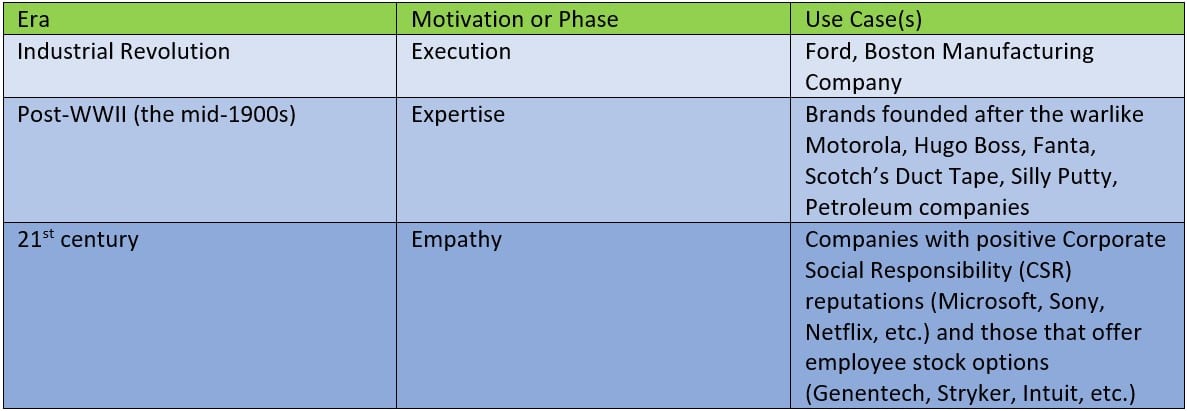
Figure 1: The eras and phases of the evolution of the concept of management, according to Rita G. McGrath, author of the article Management’s Three Eras: A Brief History (2014), published by the Harvard Business Review.
During the industrial revolution, when several American states were transforming from a purely agricultural economy to an industrial one, homegrown pioneer enterprises such as textile powerhouse Boston Manufacturing Company and automobile giant Ford were focused on mass production to gain a foothold in a largely untapped market.
Back then, management styles were largely driven by delegation, standardization, and quality control, which are all quintessential features of an assembly line and mass production. Thus, the era’s management style was strongly motivated by execution, specific, scale, standardization, and execution efficiency.
After World War II, more Americans became more educated, thanks in part to the G.I. bill, which incentivized service members who went back to school. Along with the growth of existing industries such as the automobile industry, new ones, most of which were upshots (sometimes accidental) of military technology, ingenuity, and necessity, were born.
Examples of these include Jeep, Ray-Ban’s Aviator sunglasses, and Motorola (which was then known as the Galvin Manufacturing Company), who marketed the first commercial two-way radio. Diversity and innovation became the name of the game, with scientific research being incorporated into product design and the company ethos.
Science and statistics also formed the basis of the management concepts that emerged during this period. An example of this is Peter Drucker’s Six Sigma, which later evolved to Lean Six Sigma (which we’ll discuss later). Whereas labor and production were the motivation of the previous half-century management practices, McGrath says this post-war era of management is fueled by expertise and knowledge.
Management styles for the 21st century have become a combination of these and more – the addition of an experiential component, or what McGrath calls as the motivation of empathy. There is a conscious effort from the managerial side to treat employees no longer as just subordinates but as equals.
Through employee stock purchase plans, employee perks like long vacation days, healthcare, retirement benefits, life insurance, and other competitive compensation packages, today’s management styles pay more attention to their employees’ welfare.
Take Google, Facebook, Alibaba, and other I.T. firms as examples. Have you seen their headquarters? It looks like a campus, a well-provided home, a rec center, and a modern office space all rolled into one, exuding a stress-free working environment and inspiring its employees to explore, experiment, and embrace mistakes and failure.
As one poster in the Facebook U.K. headquarters read, “try again, fail again, fail better,” a total contrast to what older employees and subordinates are used to, who are confined by the boundaries and screens of bureaucracy and autocracy.
A Facebook U.K. engineer succinctly describes the modern management style that is common nowadays with many companies and start-ups:
“The most interesting thing here is just the mindset is completely different. Engineers drive the change, whereas, in other companies, the managers usually get (sic) passing the change downwards. It’s a big difference…”
Video 1: “The Reality of Working for Facebook”
British Broadcasting Corporation (BBC). August 27, 2019
Video 2: “We Went Inside Alibaba’s Global Headquarters”
By Uptin Saiidi. CNBC International. September 10, 2019
Companies have also paid more attention to their impact on society. Market trends have turned from product creation to service creation (i.e., financial technologies, automation of manufacturing and other sectors, social media, cloud services, artificial intelligence, Internet-of-Things, or IoT), which simulate human intuition and intelligence.
Market reach has also become globalized and combined with the power of information technology. Services are now available to more consumers than ever before.
Take Facebook, again, as an example, whose user database reaches even the farthest, most under-developed, and underserved countries. Now, this is not a new phenomenon in business and economics. Still, the difference is, while managers back then would use this as leverage to increase their expected output and growth, modern-day managers would do the same and more, and that additional objective is determining where CSR or corporate social responsibility comes into play.
In many enterprises, an entire department or division is dedicated to the CSR initiatives of the company. CSR may come in many forms like philanthropy, sustainability, environmental compliance, or a combination of these. Influential multinational companies would use their global reach to benefit the underserved members of society. A use case for such is Microsoft.
Video 3: “Corporate Social Responsibility: Microsoft Case Study”
By Prof. Aldo Brunhara, Ph.D., Americas Business Channel (YouTube,) September 8, 2020
It is important to understand how management styles have evolved over the centuries because more than the knowledge about managing an enterprise, management is also about people. In the evolution of management styles, we saw how the role has grown from an autocratic role with a penchant for the bureaucracy to a more humanized business figure, one with both expertise and empathy, one that understands that to grow a business means helping your people or employees grow as well.
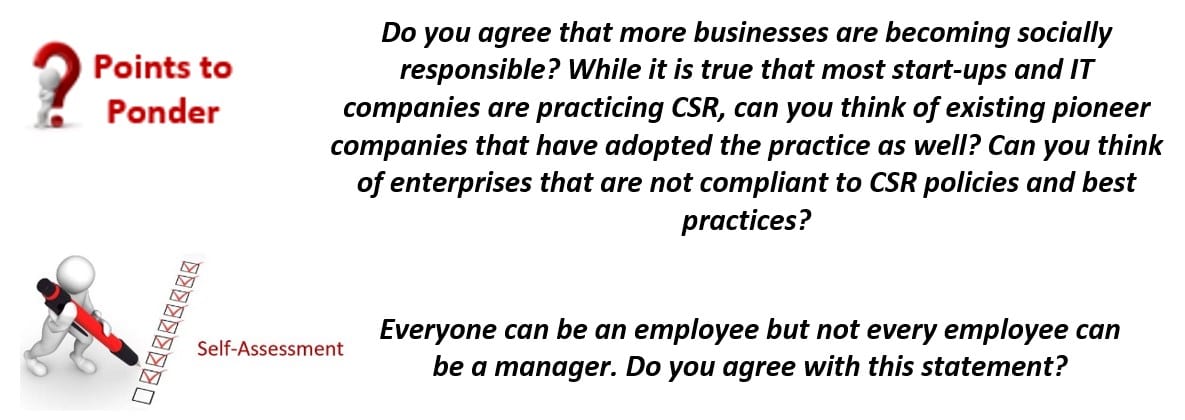

COURSE OBJECTIVES, ASSUMPTIONS AND LIMITATIONS
Course Objectives
- To gain basic or fundamental knowledge about the concept of Business Management through the theories that helped shape the discipline
- To understand the evolution of business management styles from the infancy of the concept to the present day
- To differentiate the concept of Business Management with other related areas of business expertise such as finance, economics, accountancy and business administration, etc.
Assumptions
- It is assumed that readers of this crash course have minimal, elementary, or no background at all with the overall concept of Business Management
Limitations
- Business Management is a vast concept that touches on several other areas of expertise in enterprise management. This crash course will narrow its focus to include only the definition and principles of business management, both classical and modern, as these are the fundamentals with which any novice student must be equipped.
- The crash course will also include snippets of information from other areas closely related to or often used interchangeably with business management. These include business administration, finance, economics, entrepreneurship, accountancy, human resources, and more modern project management and information systems management. These will be mentioned in dedicated sections in this crash course for clarity and distinction.

A DEEP DIVE ON:
BUSINESS MANAGEMENT
What is Business Management?
A while ago, we defined what a business manager is and how the concept of business management has evolved. Now, as we dive deeper into the subject, let’s discuss the current prevailing concepts of Business Management, a vast concept that requires a combination of hard and soft skills and a role that only the few can effectively carry out.
If you scour the web for a comprehensive definition of what Business Management is, you’ll stumble upon the following words:
- “business” and “management”
- “goals”
- “organizing”
- “planning”
- “execution”
- “monitoring”
- “resources”
- “facilitator”
- “decision-making”
- “authority”
- “bottom line of the business.”
- “purpose”
- “directed efforts”
- “in charge”
- “delegation”
- “company growth”
- “profit”
- “objectives”
- “inspire”
- “constructive”
- “tasks”
Do you sense a common theme? Business Management has something to do with attaining a company’s objectives, usually financial growth or a profit, by rallying its employees’ efforts.
Combining all, or some, of these words together, we come up with our version of a modern, modest yet comprehensive definition:
Business Management is a concept, a practice, a process, and a role all rolled into one. The management of an enterprise involves the planning, organization, monitoring, and effective execution of calculated strategies through the efficient and constructive delegation of tasks to respective lateral departments or teams to attain specific goals or objectives for a specific period of time while inspiring employees to perform at their best by employing management styles that are constructive and non-autocratic, because employees who happily work for the common goal translates to business growth and therefore, success.
Notice how the definition above evolves from an independent worker’s perspective to interdependent elements on other organization elements like teams, divisions, or departments? The planning, organizing, and monitoring tasks are focused on the individual.
Still, it is the execution of those plans and strategies that require the business manager to effectively engage their workers or employees because the execution of plans in an organization will inevitably involve several other workers.
It’s the business manager’s job not only to delegate the tasks on his plate (or desk) and make the team members understand why they need to do those tasks and how the company’s successes would also benefit them. Indeed, the concept of business management has evolved from mindless delegation to people engagement and empowerment, translating to effective action and employee retention.
The video below is Harvard Business School’s marketing material for its online Management Essentials offering. Still, it succinctly puts together all the key takeaways on what a modern-day manager is. We also debunk a few myths along the way.
Video 4: “Introduction to Management Essentials”
HBS Online. June 30, 2017
Business Management as a Role
It is easy to define a business manager’s role from a bird’s eye view: one who oversees departments or divisions of a company or a team within a project to ensure the execution of a project or company plans to attain specific goals.
But an effective and successful business manager has a balanced combination of skills and character, with emphasis on being a team player. Some (or most) companies would favor a manager who may lack the necessary skills but have exemplary character and interpersonal skills because the former can be learned or acquired, whereas the latter is usually innate.
Figure 2: Most companies favor managers who are professionally skilled and great with people. Image from the video “Learn How to Manage People and be a Better Leader” (2013) by Workforce Singapore, as uploaded on YouTube.
Innate as it may be, interpersonal skills can be developed and harnessed. Dale Carnegie’s 1935 best-seller, How to Win Friends and Influence People, proves this. In fact, without opening the book, the mere fact that it has stood the test of time and is still a popular reference, whether within the context of business management or in general, is a testament to the book’s eternal relevance to a continuously changing audience.
It has been revised edition after edition to reflect the labor marker’s current demands, the role, and industries. Time Magazine has hailed it as one of the most influential books of all time, especially business management. It is a good starting point for those keen on ascending into the managerial role, whether or not you’re equipped with people skills.
Gone are the days when managers were only tasked to delegate and monitor or, on top of these skills, were also expected to be experts in the field. When defining a business manager’s role, whether academically or in a workplace setting, character and communication abilities are par with the traditional qualifications of expertise and experience. They are thus ought to be included with the definition.
Figure 3: An effective and modern-day business manager is not only an industry expert applying his experience and knowledge to shape company methodologies, goals, and metrics. He or she must expertly navigate the tricky roadmap of human resource management within the organization as well. To effectively carry out those specific duties, managers are expected to be effective communicators, whoever the audience is, whether they’re subordinates, higher management, or clients. Image from the video “Learn How to Manage People and be a Better Leader” (2013) by Workforce Singapore, as uploaded on YouTube.
Business Management as an Academic Degree or Field of Study
Undergraduate students who are interested in entrepreneurship and the management of institutions – and not only for-profit institutions – like companies, schools, healthcare institutions like hospitals, and even government institutions and offices can opt to major in Management, which is one of the many focuses of majors under the Bachelor of Science (B.S.) in Business track at the undergraduate level.
B.S. tracks in Business have a stronger concentration in STEM subjects like mathematics, statistics, economics, accountancy, finance, and other analytical subjects. The objective is to cultivate strong analytical and technical skills necessary for graduates who will be venturing into corporate and organizational management or large business enterprises. The analysis of allocation, profit and loss, operational costs, and strategy is part of day-to-day activities.
On the other hand, a business degree can also be earned through the Bachelor of Arts track. Under a B.A. track, undergrads will gain exposure to liberal arts subjects equally important in understanding and managing a business’s operations. Subjects like communication, humanities, social science, and history, all of which were previously undervalued in the business world, are important.
This circles back to the evolution of management styles where empathy or a more humanized and less autocratic manager is what companies need from aspiring or even experienced managers. The value in learning about the liberal arts and applying the teachings in a business context is that students have a better understanding of human interaction, motivated by commerce or the law of supply and demand.
Liberal arts and the social sciences help students understand what motivates consumers to buy or procure a product or a service, or why are market trends cyclical?
So which track is better for business undergrads?
Both are equal. If we haven’t said it before, we’ll say it now – business management is both an art and a science. You can be a good business writer or communicator but may need more training with technical business concepts like Six Sigma or financial technologies, a.k.a. as fintech, and that’s fine.
Inversely, you may have solid foundations on H.R. management, payroll, accounting, or finance but will need help in conveying messages of, for example, company austerity without hinting at any notion that the company is losing more money than it makes and that is not a message you want your employees to remember. There is an effective way to convey your message without divulging information that may affect company morale.
So, you see, both tracks have their strengths. The decision will depend on which aspect of business management you are leaning into the analytical, methodical, and technical side of the humanities, social, or behavioral side.
The Difference of a Management Major versus other Business Majors
On the subject of “subjects,” let’s differentiate how majoring in Management is different from majoring in finance, economics, accountancy, and the most confusing of all for non-Business people, Business Administration.
To make the comparison simple, the keywords below are what distinguishes one major from the other:
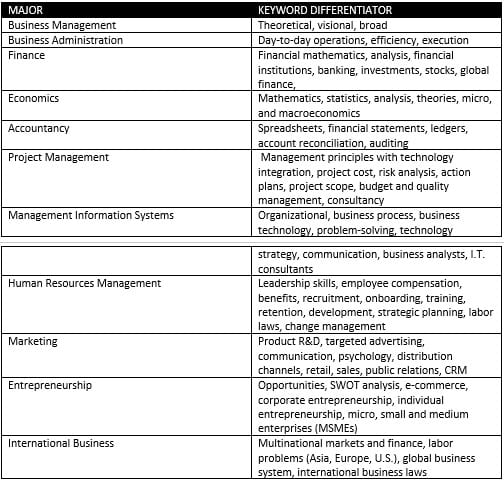
Figure 2: The Common and Business Majors and What Differentiates Each Using Keywords
Principles of Business Management
What purpose do the different principles of management serve? Why do they exist?
The principles of management circles back to the introductory part of this crash course, specifically to how management’s concept has evolved over centuries. Theories and principles usually arise as a way to explain phenomena or occurrences.
In the case of enterprises, particularly manufacturing, especially during the industrial revolution, the pace at which production was being done as well as how employees behaved when working together or alongside machinery were new phenomena that also birthed new issues and challenges:
Figure 3: Work Issues or Challenges that Emerged During the Industrial Revolution
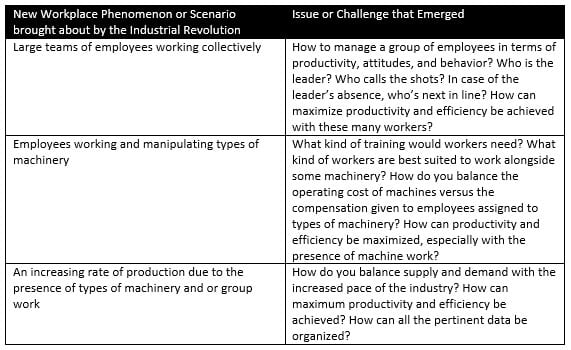
Three individuals have emerged as the pioneers after proposing principles that laid the foundation for the concept and practice of business management. Their ideas have provided early CEOs and entrepreneurs a guide on addressing the unprecedented business management challenges at the time. The ideas of Henri Fayol, Frederick Taylor, and Max Weber, which all emerged during the industrial revolution when combined, are known as the foundational theories of business management, better known as the Classical Management Theory.
Classical Management Theories
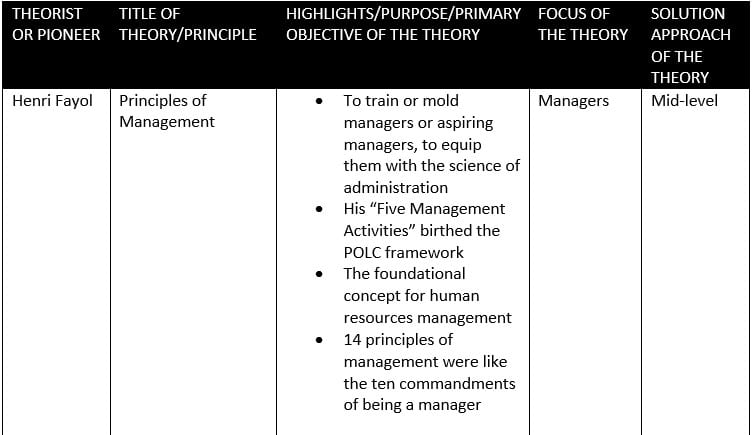
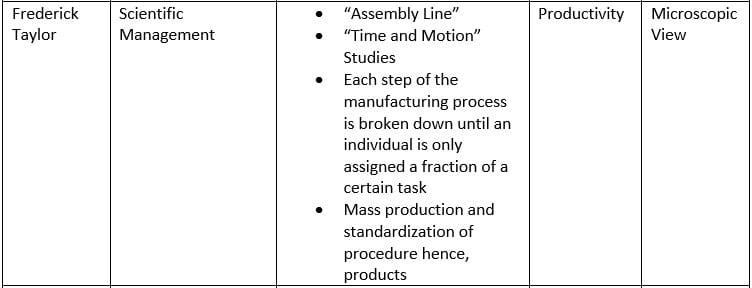
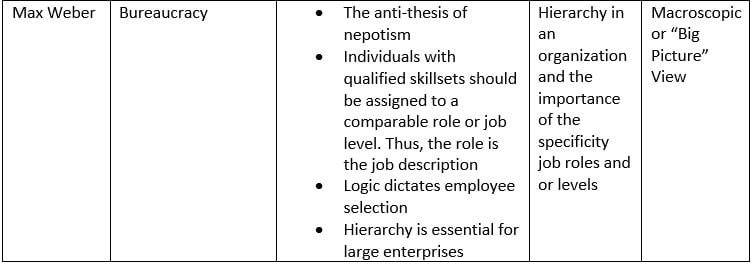
Figure 4: Classical Management Theories
Henri Fayol’s Principles of Management
Fayol’s ideas were focused on creating the perfect, ideal, or at least, the effective manager. The ideal manager can oversee production, supervise business operations, and ensure that goals are met by managing employees’ performance and behavior.
Thus, he proposed the 14 Principles of Management, where some principles are now considered traditional and obsolete, while some are still deemed relevant for both low and upper management levels.
Figure 5: Fayol’s 14 Principles of Management (in no particular order)
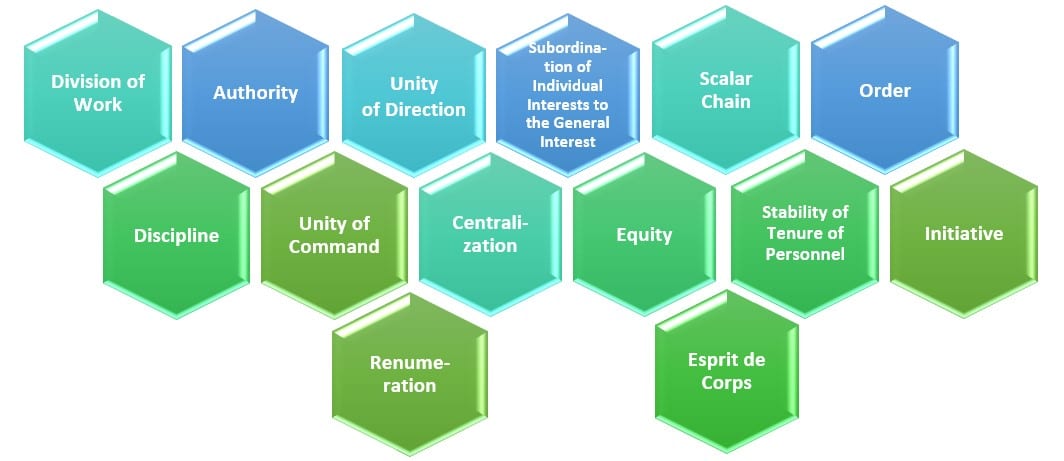
While many of the principles are self-explanatory from a managerial perspective, e.g., authority, discipline, unity of command, unity of direction, the subordination of individual interests to the general interest, order, equity, and esprit de corps, as they all point to one vital characteristic of an effective manager – leadership and the ability to balance motivation and reprimand, let’s briefly define the other principles:
- Division of Labor – speaks to the ability of the manager to recognize employees’ specialized skills or fortes and designating to them applicable tasks to increase the efficiency of operations and business production while increasing employee engagement
- Remuneration – the ability of the manager to recognize that not only does work need to be compensated (monetarily and non-monetarily), but it has to be compensated fairly or equivalent to the employee’s output, skillsets, and credentials
- Centralization and Scalar Chain – these are related as these two speak to the idea of a chain of command. Centralization means keeping the decision-making process within close ranks or only those who need to be privy to the matter at hand, while scalar chain speaks to the manager’s ability to enforce organizational hierarchy and the responsibilities and expectations that come with each level
- Initiative – this is one of the few principles in Fayol’s list that is strongly relevant in today’s changing business landscape. The initiative is already at play even back then when low-level managers and employees were mere “yes” men. This speaks to the manager’s ability to give their employees room to operate and carry out top management instructions. This, however, is an archaic definition. These days, with managers’ changing roles, whether top or low-level, the initiative is more than just allowing employees to carry out instructions with a little leeway. It is also about allowing them to seek opportunities to improve their processes, thereby increasing business throughout while allowing them to learn and develop their skillsets.
- Stability of Tenure of Personnel – managers, should increase employee engagement, thereby increasing employee retention. This also circles back to other principles like remuneration, initiative, and even division of labor. A manager should not only keep a company’s executives happy through positive numbers. Through this principle of stability of tenure, a manager should also know how to keep subordinates happy to prevent or reduce employee attrition.
Fayol’s 14 principles, when combined, form the basis of what he also proposed alongside the 14 principles as the 5 Management Activities, from which the POLC framework, which we’ll discuss later, was also based.
Figure 6: Fayol’s 5 Management Activities
To put it in simple terms:
- Planning – Effective foresight
- Coordination – Effective grouping of employees for the task at hand
- Command – Effective oversight, “micro-manage, don’t micro-manage”; lead and delegate
- Coordination – Accurate, precise, and timely communication and relaying it through the chain of command
- Control – Strict compliance to standards in all aspects of the business or the task
From a managerial perspective, Fayol’s classical theories and ideas would suffice to present the building blocks of business management as a concept, as it centered on what a manager is and how a manager should act, behave and approach the different elements of the business, particularly how to strike a balance between dealing with higher execs and subordinates, as managers are usually the bridge between these two groups.
Its essence, though, forms the basis of what a human resource (H.R.) manager should be, a subtype of a business manager focusing on people or employee management.
Frederick Taylor’s Principle of Scientific Management
Whereas Fayol’s focus was on the managers, Frederick Taylor’s focus was on refining the processes involved in making and putting out a product. Hence, the assembly line’s invention, which was both at the forefront and the manufacturing industry’s backbone.
Video 4: The Century (Taylorism)
By ABC World News Report, Presented by Peter Jennings. July 9, 1999; uploaded to YouTube by Ian Woodruff on January 17, 2014
One theory or business print that had a lasting legacy among industries across sectors, Taylorism, or Taylor’s scientific approach to improving efficiency. His “Time and Motion” studies allowed him to evaluate how long each step in a manufacturing process takes and what can be done to speed up the process while ensuring that the product or the outcome meets the minimum quality standards set by the company the industry.
Figure 7: Frederick Taylor’s notes as he designed the premise and execution of his “Time and Motion” studies using different shovel types. Image/screengrab credit from the YouTube Video “Frederick Taylor Scientific Management” from the Organizational Communication Channel, video dated September 2, 2016.
This is how the assembly line was born, and the first use case for this was Ford Motors back in the early 1900s. A present use case for the assembly line can also be seen in fast food chains, the aviation industry, and semiconductor factories.
Assigning a different person to each step of a highly extensive manufacturing process significantly increases productivity by reducing the time spent making the product. In the case of Ford Motors, when Henry Ford applied Taylor’s “Time and Motion” studies to streamline their process, it reduced their manufacturing time by as much as 90 percent.
While many companies widely adopted it, especially with the boom of the manufacturing sector in the U.S. post-World War II, Taylorism and its by-product, the assembly line, had a two-way effect on the businesses and the workforce:
The Pros and Cons of Taylorism and the Assembly Line

Figure 8: The Two-Way Effect of Taylorism
Max Weber’s Bureaucratic Management Theory (Bureaucracy)
Wrapping up the triage of the classical management theories is Max Weber’s Bureaucracy, which looks at how a business should run from a macro point of view. Weber’s Bureaucracy formulated a more legalized and rational approach to employee selection, a theme that also resonates with Taylor’s and Fayol’s ideas, although not highlighted as much.
Weber disagreed with the traditional approach to hiring people, which was practically baseless from a business requirement point of view as it employed what he called at the time “particularism.” People were hired – or not hired – based on their race, beliefs, gender, familial ties (nepotism), or connections.
According to him, a more legalized approach should be based on meritocracy, i.e., a set of minimum required standards in terms of educational attainment and skillsets, not connections or identity profiles, should measure which candidates will be weighed against.
Similarly, those who were eventually hired will have their output and performance measured against a clear set of metrics that will determine their tenure. Incentives are given to those who exceed their metrics, while those who don’t meet the standard might have to face the chopping block of termination.
Meritocracy is also the basis for Weber’s proposition of a hierarchical system of organization within enterprises. This is a pyramid-like structure or a flowchart where at the peak, is usually the company CEO. Then the chart flows down to illustrate the descending levels of the organization. At the bottom of the chart are the employees.
Large global enterprises continually employ Weber’s ideas. Even governments, democratic governments at that, is built on bureaucracy. But as with any theory from centuries ago, some aspects have become outdated, irrelevant, and even counterproductive to today’s industries.
The Pros and Cons of Weber’s Bureaucracy
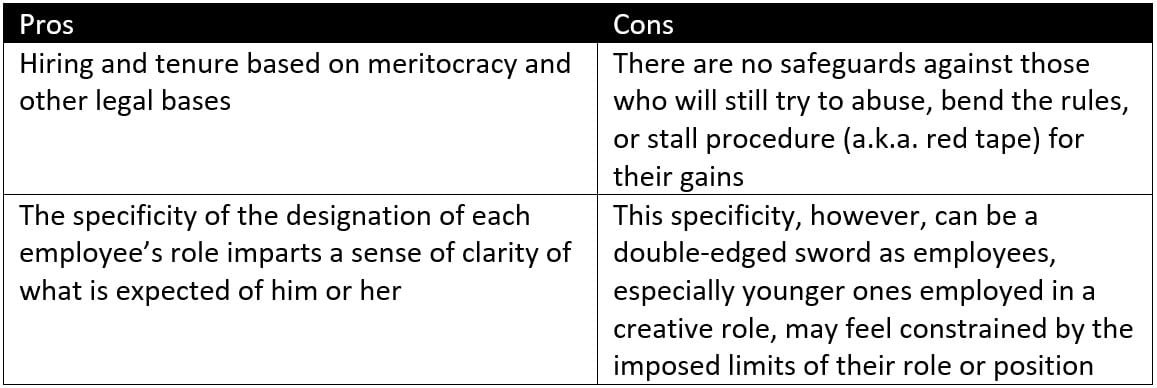
Figure 9: The Pros and Cons of Bureaucracy
We mentioned “Red Tape” as an ugly consequence or obstacle of bureaucracy. It is commonplace, especially in public offices with deep-seated and chronic corruption, but it has also been observed in the corporate setting.
The hierarchical levels bureaucracy has proposed the multitude of signatures a single office document has to go through before it lands on the intended recipient’s hand. Thus, impeding efficiency and therefore counterintuitive and defeats the purpose of assigning people to a certain task if all those people need to sign one single document.
Modern management theories come in to close the gap or the pitfalls that classical ones have created. But before we jump into that, let’s summarize what we just discussed here:
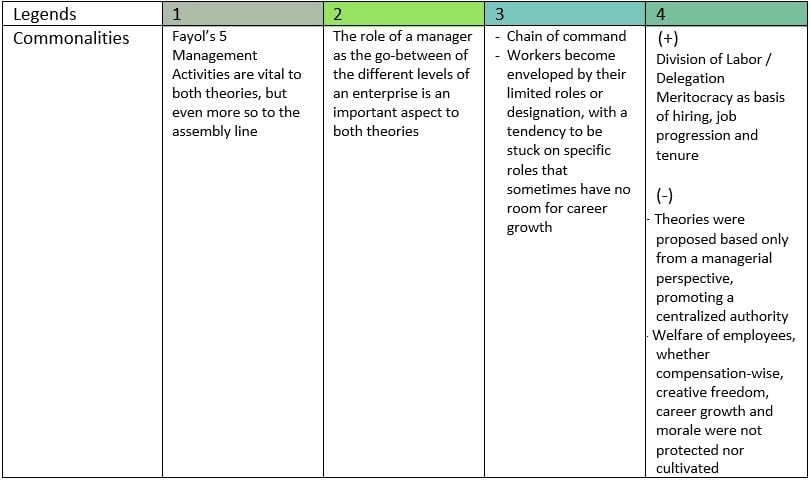
Figure 10: An Executive Summary of the Classical Management Theories and How Some Theoretical Elements Intersect. Refer to Figure 4 as necessary.
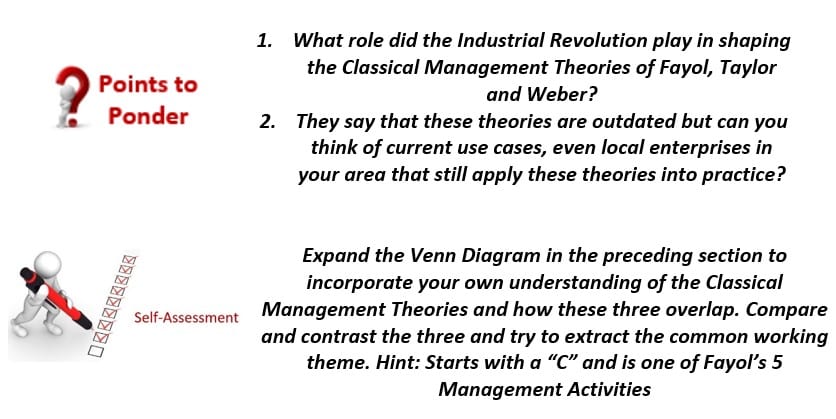
Modern Management Theories
The Classical Management Theories highly focused on the essentiality of the manager’s role because the proponents believed that effective management could streamline a business process directly proportional to its efficiency and high production rate. They left out one thing, though. It’s not just the manager’s effectivity that’s vital here, but the contentment and happiness of a company’s employees while working for them is equally important.
Like financial and material resources, human resources are equally vital to a company’s successful and efficient operations. During the industrial revolution, when the concept of human employees working side-by-side with machines was fairly new, human resources’ value was left out of the equation when theorists analyzed what makes a business successful.
The interdependence of business sectors and areas were not recognized as of yet at that time. The prevailing school of thought was a business success is tied only to the effort exerted. Management was more of a scientific discipline and never a social or behavioral one.
Then came the 21st century. There were a handful of contemporary management theories that came out during World War I and II, but we will discuss two of the most prominent theories that are still relevant to this day. Two theories brought forth the idea of a business ecosystem.
So, what is a business ecosystem?
The topic of a business ecosystem deserves its crash course. In a nutshell, a business ecosystem simply implies that everything that works for and within a specific enterprise is interdependent – the core business, customers, suppliers, creditors, supply chain, human resources, stakeholders, etc.
Figure 11: A Sample Diagram of a Business Ecosystem.
Image credit to Marikka Heikkila and Kuivaniemi, Leni (2012). Uploaded to ResearchGate
Like with any ecosystem, it is subject to constant change, sometimes gradual though it could be fast-paced at times. It is subject to expansion and evolution, which is the path to survival.
The use case for such are I.T. companies that dominate the business world today, and the best use cases are Apple and Huawei, with both companies transcending consumer electronics and venturing into communications and I.T. infrastructure, and in the case of Huawei, military technology (allegedly) as well. By expanding and diversifying their product lines, their market share and presence expand, thus shielding itself from irrelevance and obsolescence.
The concept of a business ecosystem was put forth in the 1960s as the brainchild of two publications at the time – Ludwig von Bertalanffy’s General Systems Theory and J.G. Miller’s Living Systems. Around the same time, sociologists Daniel Katz and Robert Kahn gave birth to the Systems Theory of Organizations through their 1966 published work, The Social Psychology of Organizations.
Systems Theory of Organizations
The Systems Theory of Organization, also sometimes known as the Systems Approach, is the anti-thesis of a refute of the classical management theories. Whereas the traditional theories broke down the elements, took a microscopic view, and analyzed these, Systems Theory took a holistic approach to understand how an enterprise works. It recognized the interdependence of systems, unlike the traditional view that viewed business elements like production and human resource as totally unrelated.
Mutual feedback is the main mechanism of interdependent systems to communicate with each other, cross-check (or check and balance) and maintain the interdependence.
Figure 12: A Basic Diagram of the Systems Theory or Systems Approach
Source: https://www.toppr.com/guides/fundamentals-of-economics-and-management/evolution-of-management-thought/modern-organization-theory-systems-theory/
The key concept here, aside from the interdependence of systems within an organization, is the interdependence of the core business and its subsystems to its environment or surroundings. Thus the term business ecosystem is used alongside (not synonymously) here. It’s like a domino effect; when one element of the ecosystem fails or is disrupted, all the other elements will feel the effect one way or another.
A perfect example is the disruption of the global supply chain during the first emergence of the COVID-19 outbreak. With a surge in global demand for respiratory masks and reputable manufacturer 3M, with its patented N95 masks, not meeting the demand right away, then comes an alternate manufacturer – the world’s manufacturing powerhouse, China.
By producing way more masks than 3M is capable of, China grabs 3M’s market share in just a few months, reminding the world that China is still the king when it comes to manufacturing.
Video 7: Face Mask Shortage Amid Coronavirus Pandemic Reminds World of China’s Manufacturing Dominance.
South China Morning Post YouTube Channel. March 13, 2020.
Theory X and Theory Y
Remember, when we said that Henri Fayol’s Principles of Management were like the foundational theory for human resources management? It was not the ideal theory to adapt, but it laid the groundwork for the sub-specialization of Human Resources Management.
Before the Systems Theory of the ‘60s, Douglas McGregor, who was a Professor of Management at the time at MIT, developed his idea of a Theory X and Theory Y, and the beauty of this is that it acknowledges the innate negative tendencies of humans in the workplace such as laziness and passivity (Theory X) and juxtaposes it with the innate potential of humans in the workplace such as motivation and fulfillment (Theory Y).
Theory X exposes the sad truth about the human workforce, which the classical management theories tried to address. Theory Y is sort of like the biblical passage “teach a man to fish…”. If you give workers a goal or something to work for that satisfies their inner selves or their egos aside from their pockets, you have strongly motivated workers who will perform their best for both the company and themselves.
What Theory Y offers business heads in terms of strategy is now only how to mismanage; that’s for the classical management theories and Theory X to convey. Theory Y allows business heads and managers to devise effective strategies to keep their employees engaged, secure, happy, and motivated. Things like free in-house training, upskilling, certifications, rewards, monetary or benefits, health, life insurance, and other incentives and competitive benefits packages are effective ways to help employees grow their careers while growing their business employers.
These competitive benefits packages are the current standard among multinational firms, especially in the I.T., healthcare, and consultancy industries. Another way of putting this in the simplest words is to learn to reward its employees, and the employees will surely love the job. It’s cyclical, it’s true and is backed up by another well-accepted theory – Maslow’s Hierarchy of Needs.
You see, this is what was missing in the classical management theories of the industrial revolution. It was missing because it wasn’t thought of the time. The 1900s indeed represented a shift in the business ideas that also incorporated social or behavioral components of running a business, not just systematic and tangible.
Classical Management Theories, which were all about control and outcome and can be collectively group as Theory X, have a very limited view on what motivates human beings. Theory Y touches upon that, and thanks to Maslow’s Hierarchy of Needs, it can illustrate what those deeper and more valuable needs are.
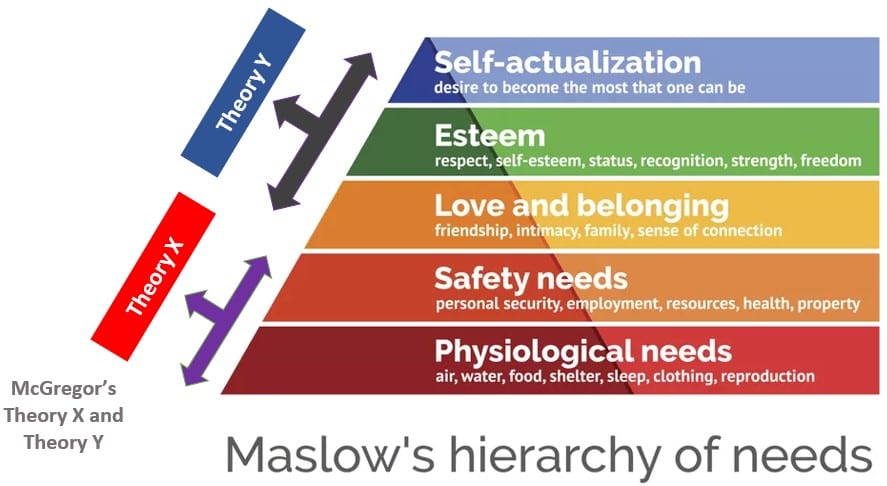
Figure 13: The Co-relation of McGregor’s Theory X and Theory Y with Maslow’s Hierarchy of Needs. Image for Maslow’s Hierarchy of Needs credited to https://www.thoughtco.com/maslows-hierarchy-of-needs-4582571


REFERENCES
- McGrath, Rita G. (2014). Management’s Three Eras: A Brief History. Harvard Business Review
- Zaleznik, Abraham (2004). Managers and Leaders: Are They Different? Harvard Business Review
- Unnamed Author. 5 of the First Manufacturing Companies in the United States. Global Electronic Services Repair (GES Repair).
- Unnamed Author. Who Made America? Public Broadcasting Service (PBS).
- O’Reilly, Lara (2015). 16 Famous Brands that Started as Products for the Military. Business Insider
- Unnamed Author. Multinational Corporations – Postwar investment: 1945–1955. American Foreign Relations.
- Addady, Michal (2016). These 10 Companies Are Generous with Stock Options. Fortune Online Magazine.
- British Broadcasting Corporation (BBC). The Reality of Working for Facebook. BBC YouTube Channel. August 27, 2019.
- Brunhara, Aldo Ph.D. (2020). Corporate Social Responsibility: Microsoft Case Study. Americas Business Channel (YouTube). September 8, 2020.
- Saiidi, Uptin (2019). We Went Inside Alibaba’s Global Headquarters. CNBC International YouTube Channel. September 10, 2019.
- Wren, Daniel A., Voich, Dan. (1976). Principles of Management: Process and Behavior. University of Michigan, Ann Arbor, Michigan, U.S.
- Taylor, Frederick W. (1911). The Principles of Scientific Management. Harper and Brothers (Harper), Manhattan, New York, US.
- Mind Tools Content Team. Henri Fayol’s Principles of Management. Mind Tools.
- Creative Commons License (2012). Management Principles v. 1.0. E-book hosted on https://2012books.lardbucket.org/
- Stanislav, Andreski (1983). Max Weber on Capitalism, Bureaucracy, and Religion: A Selection of Texts, Volume 4 (A Selection of Texts Series). Allen & Unwin, Crows Nest, Australia. (Translated)
- Lyon, Alex, Ph.D. (2017). Henri Fayol’s Principles of Management. Organizational Communication Channel. November 13, 2017
- Jennings, Peter (1999). The Century: Taylorism. Aired by the ABC World Report on July 9, 1999. Uploaded to YouTube by Ian Woodruff on January 17, 2014.
- Lyon, Alex, Ph.D. (2016). Frederick Taylor Scientific Management. Organizational Communication Channel. September 2, 2016.
- Ford Media (2013). Inside Ford’s Moving Assembly Line. Ford Media on YouTube. October 7, 2013.
- Fox 13 News – Tampa Bay (2014). Behind the Scenes of a Brand New McDonald’s. YouTube. November 22, 2014.
- McGregor, Douglas & Cutcher-Gerschenfeld, Joel (2006). The Human Side of Enterprise, Annotated Edition. McGraw-Hill, U.S.
- Heikkilä, Marikka & Kuivaniemi, Leni (2012). Ecosystem Under Construction: An Action Research Study on Entrepreneurship in a Business Ecosystem. Technology Innovation Management Review. 2. 18-24. 10.22215/timreview/564.
- Moore, James F. (1993). Predators and Prey: A New Ecology of Competition. Harvard Business Review. May-June 1993 issue.
- South China Morning Post (2020). Face Mask Shortage Amid Coronavirus Pandemic Reminds World of China’s Manufacturing Dominance. March 13, 2020. SCMP YouTube Channel.
- Lyon, Alex, Ph.D. (2017). Systems Theory of Organization. Organizational Communication Channel. November 13, 2017
- Hopper, Elizabeth (2020). Maslow’s Hierarchy of Needs Explained. ThoughtCo.
- Lyon, Alex, Ph.D. (2016). Douglas McGregor’s Theory X and Theory Y. Organizational Communication Channel. September 9, 2016.
- Elkins, Hashaw (2019). Management Theories & Concepts at the Workplace. Chron.
- Schweitzer, Karen (2017). Majoring in Project Management. ThoughtCo.
- Eller College of Management – University of Arizona. What is MIS?
Get a PDF copy of this Crash Course in Business Management by Online-Bachelor-Degrees.com
